Düsseldorf is a city on the River Rhine in western Germany and is the capital city of the state of North Rhine-Westphalia. It is one of the economic centres of the country, and a major city within the Rhine-Ruhr metropolitan area, with a population of almost 600,000.
While Frankfurt is the German hub for financial services and many other German cities excel in various branches of industry, Düsseldorf has the highest concentration of professional services, creative industries and media, and is regarded as the German capital of fashion. Düsseldorf also hosts a large number of German or European head offices of Japanese companies, and has a considerable Japanese population, forming over 1% of the city's population.
The city is famous for its nightlife, carnival, events, shopping and for fashion and trade fairs like the Boot Messe (trade fair for boats and watersports) and Igedo (fashion fair). Every year, more than 4 million people visit the Kirmes fun fair which runs for 10 days in the summer.
Düsseldorf lies on the River Rhine, or more precisely, mostly on its right (eastern) riverbank. The corresponding western riverbank is mostly occupied by the neighbouring cities of Neuss and Meerbusch except for a small bit of land on the left bank belonging to Düsseldorf, which forms the District 4.
Düsseldorf is divided into 10 districts (Stadtbezirke), which are referred to only using numbers. Those are further divided into "city parts" (Stadtteile), or neighbourhoods/quarters, which in turn have meaningful names.
Tourists are most likely to concentrate on District 1, with its quarters of Stadtmitte ("city centre") spreading northwest from the train station, as well as Altstadt ("old town") and Carlstadt on the Rhine. Many will continue further south along the Rhine through Unterbilk in District 3 to the haven (Hafen), which has been largely converted to commercial and leisure use from its original industrial and transportation functions. This whole area is rather compact, compared to the entirety of Düsseldorf, and mostly walkable.
Of the other districts and city parts, of interest to tourists may be the Benrath in District 9, with its grand palace and park and Lohausen in District 5, which contains Düsseldorf's international airport.
In German, umlauts like ü can be transcribed as ue, so the correct spelling when no umlauts are available would be Duesseldorf. While normally, incorrectly replacing an umlaut with a single vowel will simply give a nonsense word, this is not the case for Düsseldorf. In fact, "Dussel" is a dated word meaning "fool", and "dorf" means "village", so "Dusseldorf" actually means "village of fools".
Foreign guests might not know that there is rivalry between the citizens of Düsseldorf and their neighbours in Cologne. So never ever order a “Kölsch” (a light beer brewed in Cologne) in Düsseldorf. If you do, some people might become very unfriendly. If they see you are a foreigner they will no doubt forgive you.
There are two main tourist information offices in Düsseldorf:
- Tourist Information Office Hauptbahnhof, Immermannstraße 65b (opposite of the northwestern exit from the train station, +49 211 17 202 844. M-F 09:30-19:00, Sa 09:30-17:00, closed on Sundays.
- Tourist Information Office Altstadt, Marktstraße/Rheinstraße (in the old town, +49 211 17 202 840. Daily 10:00-18:00. They offer a lot of brochures: a monthly calendar of events, a city guide and free maps with walking routes designed around a specific theme (e.g., "Art Route", "Düsseldorf in 1 Hour") and, last but not least, a guide for gays. You can also book their guided tours, and note that there are also tours for disabled and deaf people.
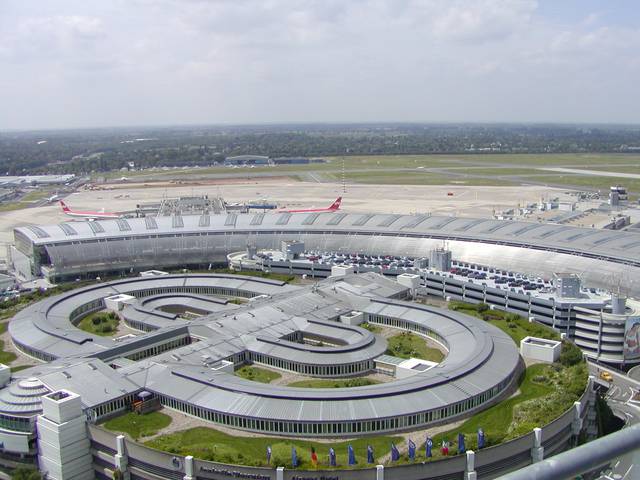
Tourist Information Office Hauptbahnhof, Immermannstraße 65b (opposite of the northwestern exit from the train station, +49 211 17 202 844. M-F 09:30-19:00, Sa 09:30-17:00, closed on Sundays.
Tourist Information Office Altstadt, Marktstraße/Rheinstraße (in the old town, +49 211 17 202 840. Daily 10:00-18:00.
The city was largely destroyed in World War II, and there were very few old buildings left. People interested in modern architecture, however, will have much to see in Düsseldorf. Also, there are many modern artworks in the public, and on Stresemannplatz Square and the Rhine Bank, there are palms, not really the first thing you'd expect to see on a cold day in October.
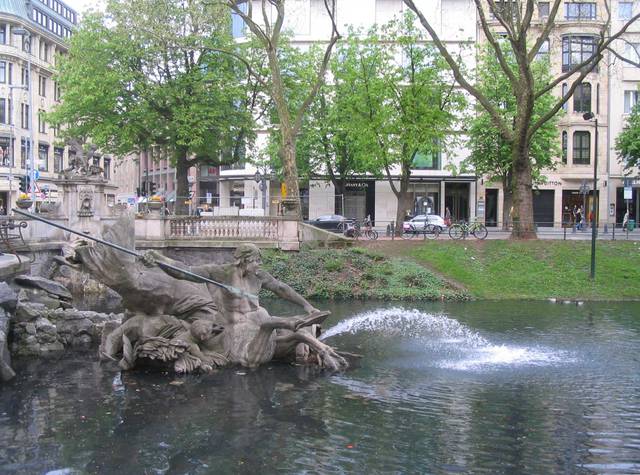
Stadtmitte is the first part of Düsseldorf most travellers see, as it extends northwest from the Hauptbahnhof. It is a very no-nonsense district mostly filled with offices and retail, with few historic buildings, but not without its charm. The Königsallee at the western end of Stadtmitte, close to the Altstadt, is an internationally famous boulevard and luxury shopping street running along both banks of the "Kögraben" canal. On balance, the area around the Hauptbahnhof may seem relatively seedy for a city lauded for its living conditions - the general rule is that the farther from the train station and closer to the "Kö", the nicer the neighbourhood. You may also want to stroll along another shopping street, the Schadowstraße - see the #Buy section of this guide for more tips.
The quarter between Berliner Allee, Klosterstraße, Charlottenstraße and Graf-Adolf-Straße is known as the Japanese quarter (Japanisches Viertel), as the many Japanese companies tend to place their head offices there. This in turn results in the proliferation of typically Japanese service providers, including many restaurants and specialist stores. Moreover, the Japanese companies often provide company apartments to their employees within the quarter. The Asian feel of the district has recently been augmented by the addition of many Chinese and South Korean establishments.
To the west of the Königsallee, encroaching on the territories of Altstadt and Carlstadt, is the Bankenviertel, where traditionally the big international, national and local banks have had their headquarters or local offices. This afforded the area between the parallel Kasernenstraße, Breite Straße and Königsallee with many impressive office buildings, many dating back to the 19th century, and continues to affect the local rents, highest in the city. Apart from banks, media (especially those concentrating on business and economics) and professional services firms also occupy much of the office space available.
By order of elector Carl Theodor the architect Nicolas de Pigage planned and implemented the first public park in Germany, named Hofgarten. It became the prototype of the English Garden of Munich. In the oldest part of Hofgarten you find the Jröne Jong (local dialect, meaning green boy). From there the “Riding Alley” leads strait forward to palace Jägerhof, which today houses the Goethe-Museum. People like the self-luminous park benches on Riding Alley. And last not least Hofgarten houses some sculptures of famous artists.
- Theatermuseum, Hofgärtnerhaus, Jägerhofstraße 1. Tu-Su 13:00-20:30.
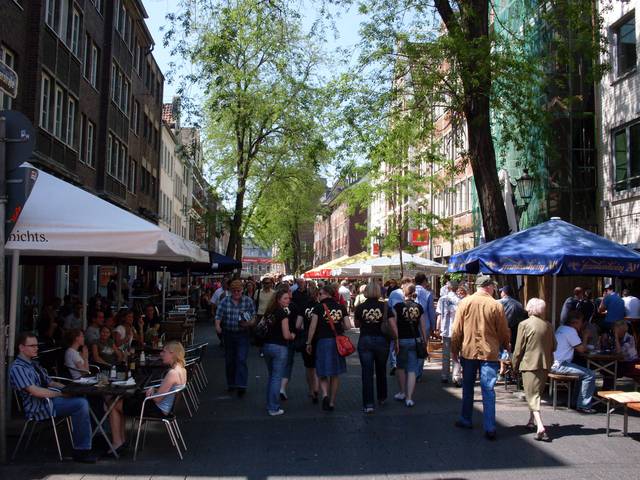
Theatermuseum, Hofgärtnerhaus, Jägerhofstraße 1. Tu-Su 13:00-20:30.
The Old Town of Düsseldorf, almost completely destroyed during World War II, was rebuilt according to historic plans on its foundation walls, which makes it look like a real historic town. Today the Altstadt is a popular shopping mall and at night and weekends turns into the “longest bar of the world”. Within one square kilometer, you will find about 260 bars, coffee shops and snug brewing houses. The old town is the home of “Altbier”, a top-fermented, dark beer. They say it tastes best at the historical brewing houses. There, the “Köbesse” (local dialect: waiters) may be somewhat harsh but they are warm hearted. If your beer glass is empty the next “Alt” comes without you even having to order it. Many times the first "Alt" comes without even having to order it!
The promenade on the bank of Rhine is one of the most beautiful ones in Germany, and it is situated on the correct side, the right bank, because the sun shines onto this side all day long (the citizens of Cologne used to say the left bank of Rhine is the correct one because the centre of Cologne is situated there), The promenade leads from Parliament via Mannesmannufer, Rathausufer, Burgplatz, and Tonhalle to Rhine-Park. It was created by constructing a tunnel in 1993 and moving motorized traffic underground, so that the riverside became a pedestrian area. Most gangways for boat trips on Rhine are situated near to Burgplatz. Many coffee shops offer seats outside where you can watch and be watched when the weather is fine. The pavement of the promenade is an artwork too; its sinuous design reflects the waves on the river.
Inside the old town, but everywhere in the city also, you will find lots of marvellous old gas lamps. Beside Berlin Düsseldorf is the city with the most gas lamps in Germany.
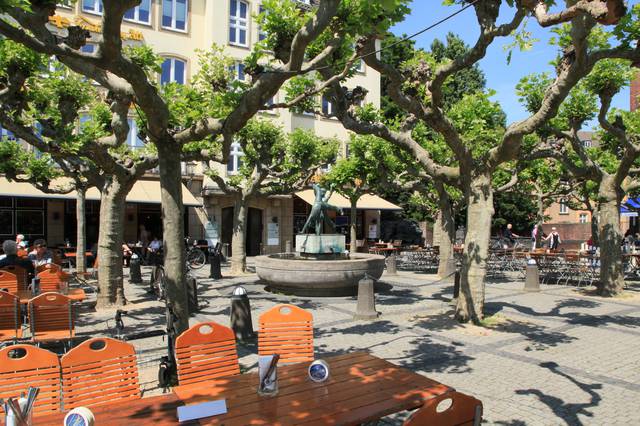
- Burgplatz. At the old town limits next to Rhine. Here was the erstwhile castle of the Earls of Berg, the later duke of Jülich-Kleve-Berg. Later the castle was reconstructed to a baroque palace, which burned down in 1872. In 1888 the ruins were removed completely, and only a tower was left. Today the tower houses an inland navigation museum. The coffee-shop in the towers top offers a grand view onto the Rhine and the ships passing by. The square itself got an award as one of the nicest squares in Germany after World War II
- Cartwheelers' Fountain, at Burgplatz. Radschläger wolle mer blieve, wie jeck et de Mensche och drieve (local dialect: "we will stay cartwheelers, however crazy the world might be") is the legend of the fountain. It is under some wonderful old plane trees. The cartwheeler is a popular symbol within Düsseldorf and cartwheeling an old tradition. According to legend, after winning the War of Worringen, the Earl of Berg said to the boys waiting for their fathers, “Show me that you're happy about your fathers' return”, and they began cartwheeling. Even today this tradition is continued by annual competitions.
- City Monument, at Burgplatz. is an artwork of Bert Gerresheim, donated by the society “Düsseldorfer Jongens” on occasion of the 700th anniversary of town foundation. It is a kaleidoscope of local history, starting on left side with the cruel battle of Worringen, the signing of foundation documents by the earl of Berg in the middle and several scenes on right side including 4 popes. Among them we see Nikolaus IV raising St. Lambertus Church to a canon monastery. A market scene is shown, but also trade goods of Düsseldorf. The monument is full of symbols. You should go nearby and take account of details. You also should go some steps back. Mind the men following the apocalyptic horse riders on the left side. Their arms form the number 1288, the year of the battle of Worringen. During the battle, the Earl of Berg, Adolf V, fought against the Archbishop of Cologne, Sigfried of Westerburg. The citizens of Düsseldorf and the citizens of Cologne united in backing Adolf V (ironically in view of their future rivalry). The battle ended with the victory of the earl and the citizens.
- Schifffahrtmuseum Düsseldorf, Burgplatz 30. Tu-Su 11:00-18:00. The shipping museum in the old castle tower. €3.
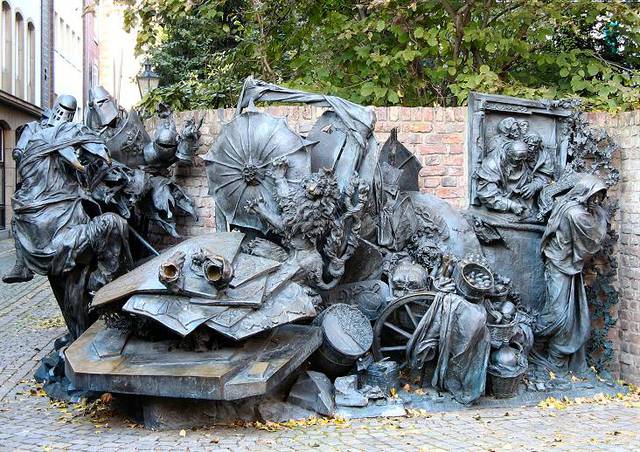
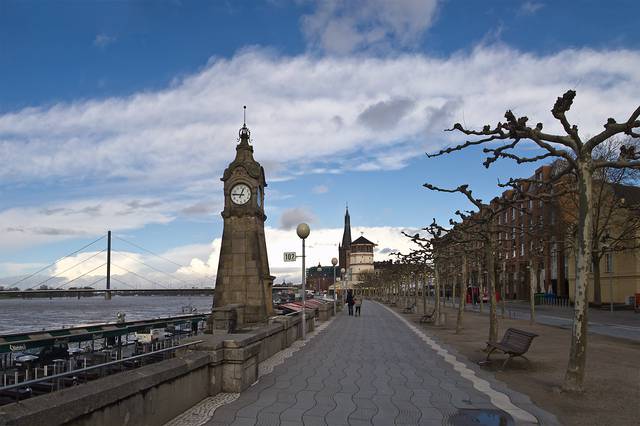
- Pegeluhr. Situated at the Rhine bank this clock also shows the current water level in the river.
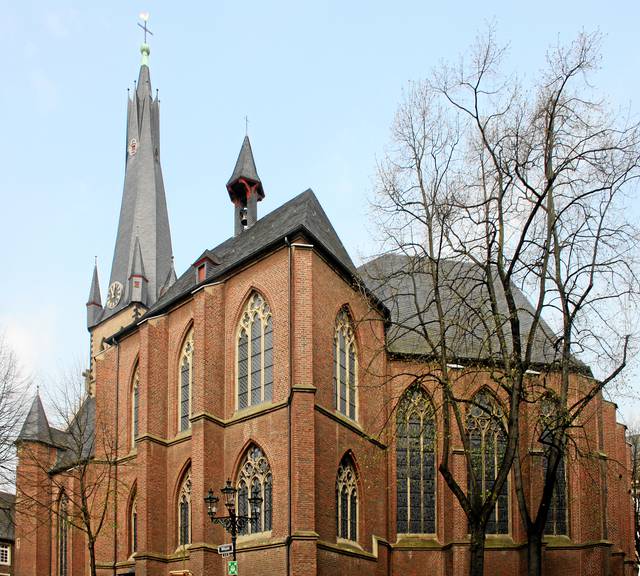
- St. Lambertus Basilika. built with bricks in the style of Lower Rhine Gothic, is a landmark of Düsseldorf. The church-hall was the last residence of St. Apollinaris, the city’s patron.
A particular characteristic is the winding tower. Although there are legends saying they used wet arbors for reconstructing after a fire in 1815, locals know better. They say that about 100 years ago, a bride dressed in a snow-white wedding dress came to the altar pretending to be a virgin. Being ashamed, the tower turned aside. They also say that it will straighten again if a real virgin appears at the altar. As you can clearly see, the tower is still twisted. But the fact is, the citizens love their twisted tower. After the war, it was reconstructed as twisted as it was before.
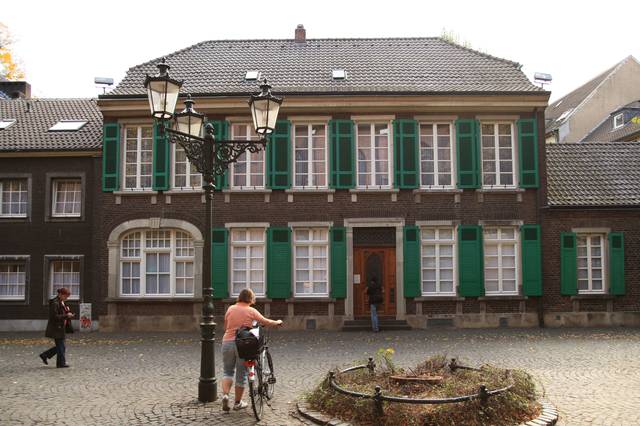
- Stiftsplatz. The square breathes a contemplative tranquility, only 100 meters beside the loud old town. Follow Lambertus-Street forwards. Near the intersection with “Liefergasse”, you see a marvellous house front on your left. There are many fine fronts in Düsseldorf, but this one is among the prettiest.
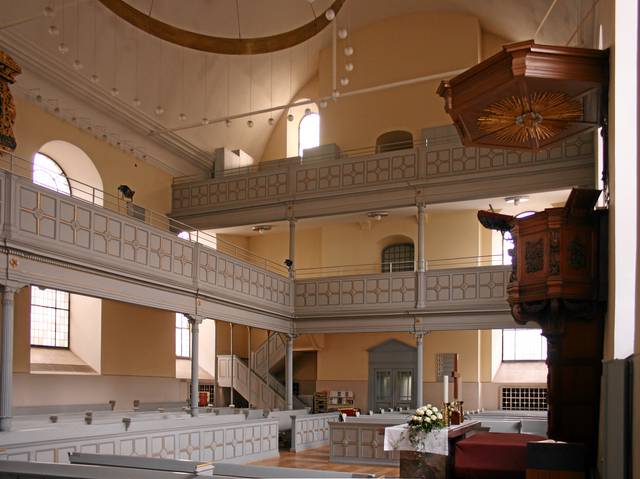
- Neanderkirche. has its own history too. The population of the Rhinelands is mainly Catholic, and Protestants and members of the Reformed Church had to suffer many restrictions. Finally, the Contract of Rheinberg 1682 granted everybody the free practice of religion. This led to the construction of the Reformed church-house at Bolkerstraße in 1683 in a style of the early baroque with a simplified façade. Although the Protestants and members of the reformed church had the right to their own churches, they were not well-liked. So the new church had to be built in a way that was not visible from the street, meaning in the yard of already existing buildings. But today you have an unlimited view onto the church from Bolkerstraße because the building that used to block the view was the only one not rebuilt after the war. In 1916, the church got the name Neander-Church.
- Nördliche Düssel. On the right hand of the monument is a little river, named the northern Düssel. It gave the city its name (Düsseldorf means village at Düssel). The balustrade is an artwork of Bert Gerreshein too. It is also full of symbols.
- Birthplace of Heinrich Heine, Bolkerstraße 56. Heine (1797-1856) was a poet and author and perhaps the most famed Düsseldorfer in German history
- Schneider-Wibbel-Gasse. A small lane inside the old town, connecting Bolkerstraße and Flingerstraße. It is packed with restaurants and bars, most of them offering Spanish-American and Latin American food (particularly Argentinian). Tailor Wibbel is the main character of a popular theatre play, written by Hans Müller-Schlösser in 1913. Tailor Wibbel had opposed Napoleon and, therefore, was sent to prison. But, instead of himself, his assistant went to jail under the name of Wibbel. Unfortunately, the assistant died in prison as a result of a former disease, so the actual Wibbel was able to witness his own burial incognito. After the end of the French occupation, Wibbel had the chance to disclose his identity and became a local hero. Across Bolkerstraße is the Wibble clock. Daily, at 11:00, 13:00, 15:00, 18:00 and 21:00, it shows the Wibbel character. At the other end of Tailor Wibbel Lane, near Flingerstraße, is the Wibble sculpture. Walk near by and examine the sculpture. Did you see the mouse?
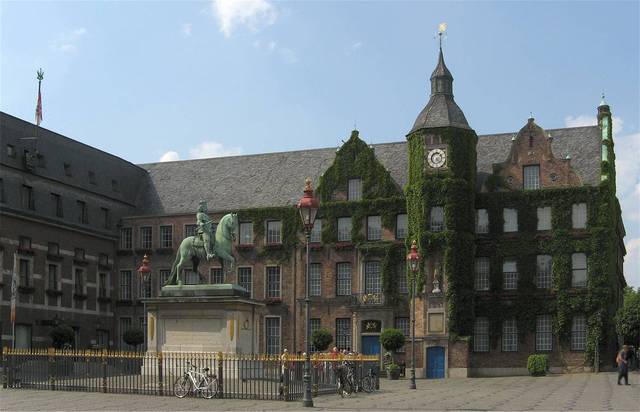
- Rathaus. The historic and striking city hall of Düsseldorf dates from the 16th century. Since then it has housed the city parliament. The building consists of three parts, and there are guided tours for free every Wednesday at 15:00. They will show you the council hall, the Jan-Wellem hall and the reception hall of the Lord Mayor where they present the city’s silver coins and roof-paintings of the artists Domenico Zanetti and Johannes Spilberg.
- Jan Wellem. In front of the city hall is the monument of elector Johann Wilhelms II (1658-1716) on horseback. The citizens affectionately call him Jan Wellem. His monument is among the most important baroque equestrian sculptures north of the Alps. Because of his connections to European dynasties and by the powers invested in him he was a very important man. In co-operation with other electors he elected the German Emperor. He was a representative of a pompous baroque sovereign. In 1691 he married Anna Maria Luisa de‘ Medici (1667-1743). Jan Wellem died in 1716; his grave site is in St. Andreas-Church. Jan Wellem boosted the development of Düsseldorf, so the citizens still love him. The monument was realised by Gabriel Grupello in 1711.
- Gießer-Junge. At the side of market square, in the shadow of Jan Wellem, stands the statue of the cast boy. They say that just before the cast of the Jan Wellem monument master Grupello realised that the amount oft metal was not sufficient. This prompted the cast boy ask the citizens for a donation of noble metal like silver forks or coins. He got so much that the cast could be finished very well. Out of thankfulness he got a statue too. The one you see today was designed by Willi Hoselmann and realised in 1932.
- Wilhelm-Marx-Haus. The Wilhelm-Marx-Haus was the first Hochhaus, or highrise building, in Germany and, apparently, in Europe. Finished in 1924, it is 57 meters high and has 13 floors above ground level. The architect was Wilhelm Kreis. It used to be the home of the Düsseldorf Stock Exchange and includes a theatre. It is named after Wilhelm Marx, who was mayor of Düsseldorf in the early 20th century and started a programme for the modernisation of the city at that time.
- Filmmuseum Düsseldorf, Schulstraße 4. Tu-Su 11:00-17:00, W 11:00-21:00.
- K20 Kunstsammlung NRW, Grabbeplatz 5 (K20: Heinrich-Heine-Allee Ubf, K21: Graf-Adolf-Platz (bus/tram), +49 211 83 81 130. T-F 10:00-18:00, Sa Su and holidays 11:00-18:00. Kunstsammlung NRW has two building, K20 at Altstadt and K21 in Carlstadt. K20 has a great collection of 20th-century art, including Picasso, Klee, Richter, Kandinsky, and Warhol. €6.50, €10.00 K20+K21.
Burgplatz. At the old town limits next to Rhine. Here was the erstwhile castle of the Earls of Berg, the later duke of Jülich-Kleve-Berg. Later the castle was reconstructed to a baroque palace, which burned down in 1872. In 1888 the ruins were removed completely, and only a tower was left. Today the tower houses an inland navigation museum. The coffee-shop in the towers top offers a grand view onto the Rhine and the ships passing by. The square itself got an award as one of the nicest squares in Germany after World War II
- Cartwheelers' Fountain, at Burgplatz. Radschläger wolle mer blieve, wie jeck et de Mensche och drieve (local dialect: "we will stay cartwheelers, however crazy the world might be") is the legend of the fountain. It is under some wonderful old plane trees. The cartwheeler is a popular symbol within Düsseldorf and cartwheeling an old tradition. According to legend, after winning the War of Worringen, the Earl of Berg said to the boys waiting for their fathers, “Show me that you're happy about your fathers' return”, and they began cartwheeling. Even today this tradition is continued by annual competitions.
- City Monument, at Burgplatz. is an artwork of Bert Gerresheim, donated by the society “Düsseldorfer Jongens” on occasion of the 700th anniversary of town foundation. It is a kaleidoscope of local history, starting on left side with the cruel battle of Worringen, the signing of foundation documents by the earl of Berg in the middle and several scenes on right side including 4 popes. Among them we see Nikolaus IV raising St. Lambertus Church to a canon monastery. A market scene is shown, but also trade goods of Düsseldorf. The monument is full of symbols. You should go nearby and take account of details. You also should go some steps back. Mind the men following the apocalyptic horse riders on the left side. Their arms form the number 1288, the year of the battle of Worringen. During the battle, the Earl of Berg, Adolf V, fought against the Archbishop of Cologne, Sigfried of Westerburg. The citizens of Düsseldorf and the citizens of Cologne united in backing Adolf V (ironically in view of their future rivalry). The battle ended with the victory of the earl and the citizens.
Burgplatz. At the old town limits next to Rhine. Here was the erstwhile castle of the Earls of Berg, the later duke of Jülich-Kleve-Berg. Later the castle was reconstructed to a baroque palace, which burned down in 1872. In 1888 the ruins were removed completely, and only a tower was left. Today the tower houses an inland navigation museum. The coffee-shop in the towers top offers a grand view onto the Rhine and the ships passing by. The square itself got an award as one of the nicest squares in Germany after World War II
- Cartwheelers' Fountain, at Burgplatz. Radschläger wolle mer blieve, wie jeck et de Mensche och drieve (local dialect: "we will stay cartwheelers, however crazy the world might be") is the legend of the fountain. It is under some wonderful old plane trees. The cartwheeler is a popular symbol within Düsseldorf and cartwheeling an old tradition. According to legend, after winning the War of Worringen, the Earl of Berg said to the boys waiting for their fathers, “Show me that you're happy about your fathers' return”, and they began cartwheeling. Even today this tradition is continued by annual competitions.
- City Monument, at Burgplatz. is an artwork of Bert Gerresheim, donated by the society “Düsseldorfer Jongens” on occasion of the 700th anniversary of town foundation. It is a kaleidoscope of local history, starting on left side with the cruel battle of Worringen, the signing of foundation documents by the earl of Berg in the middle and several scenes on right side including 4 popes. Among them we see Nikolaus IV raising St. Lambertus Church to a canon monastery. A market scene is shown, but also trade goods of Düsseldorf. The monument is full of symbols. You should go nearby and take account of details. You also should go some steps back. Mind the men following the apocalyptic horse riders on the left side. Their arms form the number 1288, the year of the battle of Worringen. During the battle, the Earl of Berg, Adolf V, fought against the Archbishop of Cologne, Sigfried of Westerburg. The citizens of Düsseldorf and the citizens of Cologne united in backing Adolf V (ironically in view of their future rivalry). The battle ended with the victory of the earl and the citizens.
Burgplatz. At the old town limits next to Rhine. Here was the erstwhile castle of the Earls of Berg, the later duke of Jülich-Kleve-Berg. Later the castle was reconstructed to a baroque palace, which burned down in 1872. In 1888 the ruins were removed completely, and only a tower was left. Today the tower houses an inland navigation museum. The coffee-shop in the towers top offers a grand view onto the Rhine and the ships passing by. The square itself got an award as one of the nicest squares in Germany after World War II
- Cartwheelers' Fountain, at Burgplatz. Radschläger wolle mer blieve, wie jeck et de Mensche och drieve (local dialect: "we will stay cartwheelers, however crazy the world might be") is the legend of the fountain. It is under some wonderful old plane trees. The cartwheeler is a popular symbol within Düsseldorf and cartwheeling an old tradition. According to legend, after winning the War of Worringen, the Earl of Berg said to the boys waiting for their fathers, “Show me that you're happy about your fathers' return”, and they began cartwheeling. Even today this tradition is continued by annual competitions.
- City Monument, at Burgplatz. is an artwork of Bert Gerresheim, donated by the society “Düsseldorfer Jongens” on occasion of the 700th anniversary of town foundation. It is a kaleidoscope of local history, starting on left side with the cruel battle of Worringen, the signing of foundation documents by the earl of Berg in the middle and several scenes on right side including 4 popes. Among them we see Nikolaus IV raising St. Lambertus Church to a canon monastery. A market scene is shown, but also trade goods of Düsseldorf. The monument is full of symbols. You should go nearby and take account of details. You also should go some steps back. Mind the men following the apocalyptic horse riders on the left side. Their arms form the number 1288, the year of the battle of Worringen. During the battle, the Earl of Berg, Adolf V, fought against the Archbishop of Cologne, Sigfried of Westerburg. The citizens of Düsseldorf and the citizens of Cologne united in backing Adolf V (ironically in view of their future rivalry). The battle ended with the victory of the earl and the citizens.
Schifffahrtmuseum Düsseldorf, Burgplatz 30. Tu-Su 11:00-18:00. The shipping museum in the old castle tower. €3.
Pegeluhr. Situated at the Rhine bank this clock also shows the current water level in the river.
St. Lambertus Basilika. built with bricks in the style of Lower Rhine Gothic, is a landmark of Düsseldorf. The church-hall was the last residence of St. Apollinaris, the city’s patron.
A particular characteristic is the winding tower. Although there are legends saying they used wet arbors for reconstructing after a fire in 1815, locals know better. They say that about 100 years ago, a bride dressed in a snow-white wedding dress came to the altar pretending to be a virgin. Being ashamed, the tower turned aside. They also say that it will straighten again if a real virgin appears at the altar. As you can clearly see, the tower is still twisted. But the fact is, the citizens love their twisted tower. After the war, it was reconstructed as twisted as it was before.
Stiftsplatz. The square breathes a contemplative tranquility, only 100 meters beside the loud old town. Follow Lambertus-Street forwards. Near the intersection with “Liefergasse”, you see a marvellous house front on your left. There are many fine fronts in Düsseldorf, but this one is among the prettiest.
Neanderkirche. has its own history too. The population of the Rhinelands is mainly Catholic, and Protestants and members of the Reformed Church had to suffer many restrictions. Finally, the Contract of Rheinberg 1682 granted everybody the free practice of religion. This led to the construction of the Reformed church-house at Bolkerstraße in 1683 in a style of the early baroque with a simplified façade. Although the Protestants and members of the reformed church had the right to their own churches, they were not well-liked. So the new church had to be built in a way that was not visible from the street, meaning in the yard of already existing buildings. But today you have an unlimited view onto the church from Bolkerstraße because the building that used to block the view was the only one not rebuilt after the war. In 1916, the church got the name Neander-Church.
Nördliche Düssel. On the right hand of the monument is a little river, named the northern Düssel. It gave the city its name (Düsseldorf means village at Düssel). The balustrade is an artwork of Bert Gerreshein too. It is also full of symbols.
Birthplace of Heinrich Heine, Bolkerstraße 56. Heine (1797-1856) was a poet and author and perhaps the most famed Düsseldorfer in German history
Schneider-Wibbel-Gasse. A small lane inside the old town, connecting Bolkerstraße and Flingerstraße. It is packed with restaurants and bars, most of them offering Spanish-American and Latin American food (particularly Argentinian). Tailor Wibbel is the main character of a popular theatre play, written by Hans Müller-Schlösser in 1913. Tailor Wibbel had opposed Napoleon and, therefore, was sent to prison. But, instead of himself, his assistant went to jail under the name of Wibbel. Unfortunately, the assistant died in prison as a result of a former disease, so the actual Wibbel was able to witness his own burial incognito. After the end of the French occupation, Wibbel had the chance to disclose his identity and became a local hero. Across Bolkerstraße is the Wibble clock. Daily, at 11:00, 13:00, 15:00, 18:00 and 21:00, it shows the Wibbel character. At the other end of Tailor Wibbel Lane, near Flingerstraße, is the Wibble sculpture. Walk near by and examine the sculpture. Did you see the mouse?
Rathaus. The historic and striking city hall of Düsseldorf dates from the 16th century. Since then it has housed the city parliament. The building consists of three parts, and there are guided tours for free every Wednesday at 15:00. They will show you the council hall, the Jan-Wellem hall and the reception hall of the Lord Mayor where they present the city’s silver coins and roof-paintings of the artists Domenico Zanetti and Johannes Spilberg.
Jan Wellem. In front of the city hall is the monument of elector Johann Wilhelms II (1658-1716) on horseback. The citizens affectionately call him Jan Wellem. His monument is among the most important baroque equestrian sculptures north of the Alps. Because of his connections to European dynasties and by the powers invested in him he was a very important man. In co-operation with other electors he elected the German Emperor. He was a representative of a pompous baroque sovereign. In 1691 he married Anna Maria Luisa de‘ Medici (1667-1743). Jan Wellem died in 1716; his grave site is in St. Andreas-Church. Jan Wellem boosted the development of Düsseldorf, so the citizens still love him. The monument was realised by Gabriel Grupello in 1711.
Gießer-Junge. At the side of market square, in the shadow of Jan Wellem, stands the statue of the cast boy. They say that just before the cast of the Jan Wellem monument master Grupello realised that the amount oft metal was not sufficient. This prompted the cast boy ask the citizens for a donation of noble metal like silver forks or coins. He got so much that the cast could be finished very well. Out of thankfulness he got a statue too. The one you see today was designed by Willi Hoselmann and realised in 1932.
Wilhelm-Marx-Haus. The Wilhelm-Marx-Haus was the first Hochhaus, or highrise building, in Germany and, apparently, in Europe. Finished in 1924, it is 57 meters high and has 13 floors above ground level. The architect was Wilhelm Kreis. It used to be the home of the Düsseldorf Stock Exchange and includes a theatre. It is named after Wilhelm Marx, who was mayor of Düsseldorf in the early 20th century and started a programme for the modernisation of the city at that time.
Filmmuseum Düsseldorf, Schulstraße 4. Tu-Su 11:00-17:00, W 11:00-21:00.
K20 Kunstsammlung NRW, Grabbeplatz 5 (K20: Heinrich-Heine-Allee Ubf, K21: Graf-Adolf-Platz (bus/tram), +49 211 83 81 130. T-F 10:00-18:00, Sa Su and holidays 11:00-18:00. Kunstsammlung NRW has two building, K20 at Altstadt and K21 in Carlstadt. K20 has a great collection of 20th-century art, including Picasso, Klee, Richter, Kandinsky, and Warhol. €6.50, €10.00 K20+K21.
Carlstadt is Düsseldorf's smallest Bezirk by area, whose development started in late 18th century when the old fortifications of the city became obsolete and the need for more housing pressing. It is named after Prince-Elector Carl Theodor, whose domain encompassed the city at that time. Different in character from the business-oriented Stadtmitte and noisy Altstadt, the Carlstadt charms with its baroque façades, chess-board-like street plan and relative prevalence of greens.
Carlstadt is known for its many antique and art traders, upscale jewellery stores, as well as many museums, galleries and other cultural institutions. Among the artists who have over the years chosen to live in the area were Clara and Robert Schumann. The most commercially active are the Bilker Straße and Hohe Straße. A more historic part of the Bezirk is to be found between the Citadellstraße, Schulstraße and Anna-Maria-Luisa-Medici-Platz.
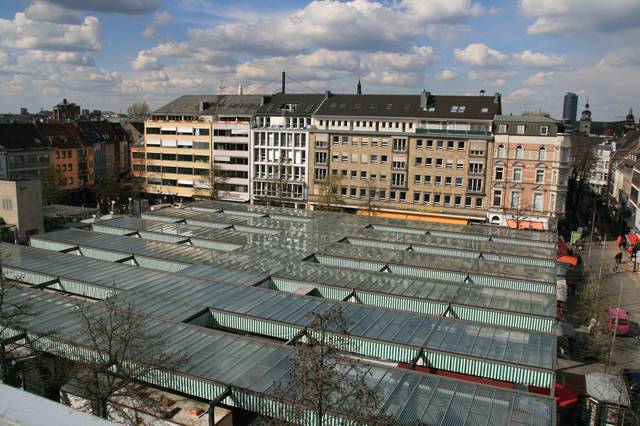
- Carlsplatz. The Carlsplatz is the centre of Carlstadt and houses the city's only permanent weekday market, featuring savory food, sweets, flowers as well as popular artworks
- Maxkirche. The late baroque church was built in mid-17th century for the Franciscan convent and, after its dissolution in 1804, was renamed St. Maximillian as a nod towards the then-Elector to protect it from destruction. The church is renowned for its organ music and choir.
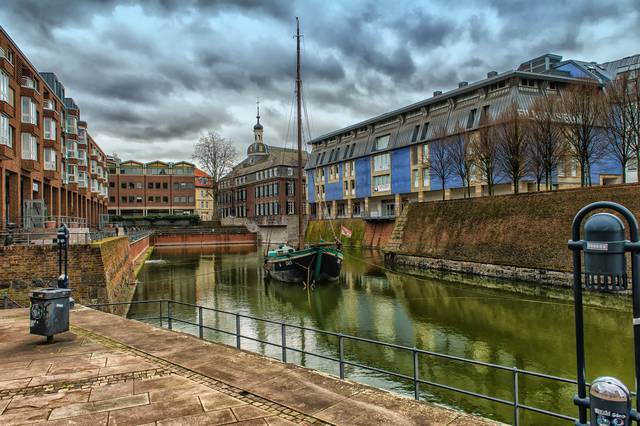
- Alter Hafen. Neither a haven nor actually old, the Alter Hafen occupies the area that was once the haven of the fortress of Düsseldorf. Today it is not connected to the Rhine, nor is it actually deep enough (there is a parking garage and tunnel underneath) to serve as a haven, and is surrounded by buildings constructed after the Second World War, but it still a very nice area for a stroll.
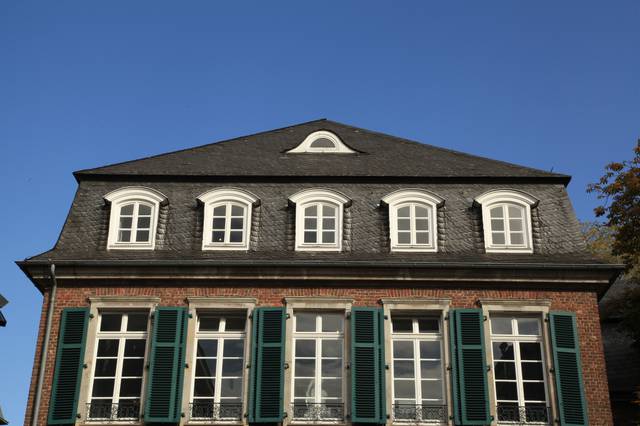
- Palais Nesselrode, Schulstraße 4. Tues-Sun 11-17, Wed 11-21.
- Palais Wittgenstein, Bilker Straße 7-9. The residences at Bilker Straße 7 and 9 have both rich history (including ownership by Prince von Sayn-Wittgenstein, which gave them the name), and are owned by the municipality. They were reconstructed in the 1970s with their historic façades preserved, but the interior was redeveloped to house cultural institutions. Today it is the home to the Marionetten-Theater, a chamber music hall and the Institut Francais
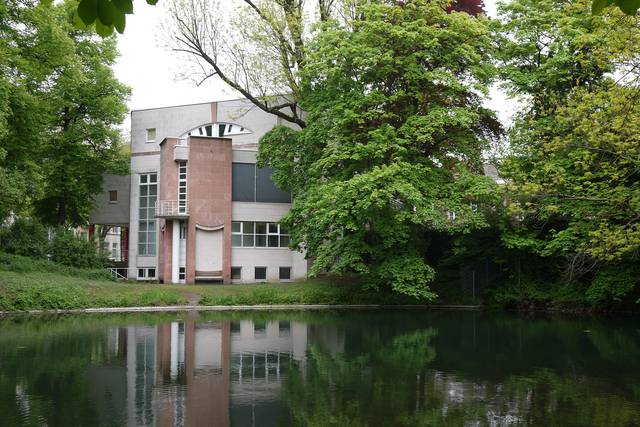
- Stadtmuseum, Berger Allee 2. Tues-Sun 11-18. The municipal museum features collections of artifacts, art and photographs related to the history of the city. It is located in the reconstructed baroque Palais Spee (as well as a postmodern west wing added in the 1970s), which features and extensive garden park with a pond formed from the Südliche Düssel. Even if you pass on the museum's collections, the park is worth a visit.
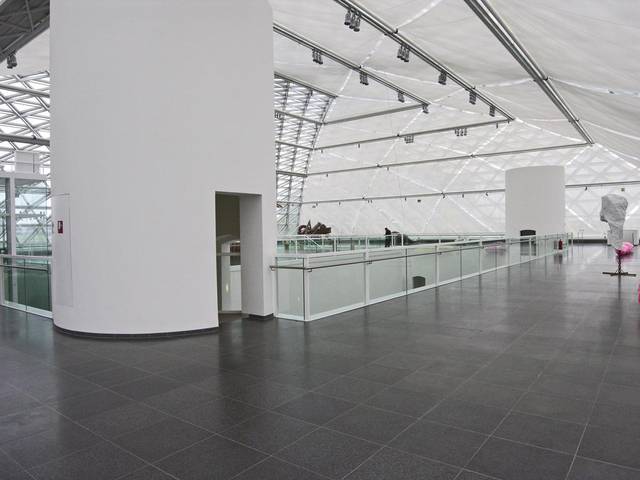
- K21 Kunstsammlung NRW, Ständehausstraße 1, 40217 Düsseldorf (Graf-Adolf-Platz (bus/tram), +49 211 83 81 130. Tue-Fri 10:00-18:00, Sat-Sun and Holidays 11:00-18:00. Kunstsammlung NRW has two buildings, K20 at Altstadt and K21 in Carlstadt. K21 houses modern art collection after 1960s, mainly from local artists. €6.50, € 10 K20+K21, free entrance on the first Wednesday of every month.
Carlsplatz. The Carlsplatz is the centre of Carlstadt and houses the city's only permanent weekday market, featuring savory food, sweets, flowers as well as popular artworks
Maxkirche. The late baroque church was built in mid-17th century for the Franciscan convent and, after its dissolution in 1804, was renamed St. Maximillian as a nod towards the then-Elector to protect it from destruction. The church is renowned for its organ music and choir.
Alter Hafen. Neither a haven nor actually old, the Alter Hafen occupies the area that was once the haven of the fortress of Düsseldorf. Today it is not connected to the Rhine, nor is it actually deep enough (there is a parking garage and tunnel underneath) to serve as a haven, and is surrounded by buildings constructed after the Second World War, but it still a very nice area for a stroll.
Palais Nesselrode, Schulstraße 4. Tues-Sun 11-17, Wed 11-21.
Palais Wittgenstein, Bilker Straße 7-9. The residences at Bilker Straße 7 and 9 have both rich history (including ownership by Prince von Sayn-Wittgenstein, which gave them the name), and are owned by the municipality. They were reconstructed in the 1970s with their historic façades preserved, but the interior was redeveloped to house cultural institutions. Today it is the home to the Marionetten-Theater, a chamber music hall and the Institut Francais
Stadtmuseum, Berger Allee 2. Tues-Sun 11-18. The municipal museum features collections of artifacts, art and photographs related to the history of the city. It is located in the reconstructed baroque Palais Spee (as well as a postmodern west wing added in the 1970s), which features and extensive garden park with a pond formed from the Südliche Düssel. Even if you pass on the museum's collections, the park is worth a visit.
K21 Kunstsammlung NRW, Ständehausstraße 1, 40217 Düsseldorf (Graf-Adolf-Platz (bus/tram), +49 211 83 81 130. Tue-Fri 10:00-18:00, Sat-Sun and Holidays 11:00-18:00. Kunstsammlung NRW has two buildings, K20 at Altstadt and K21 in Carlstadt. K21 houses modern art collection after 1960s, mainly from local artists. €6.50, € 10 K20+K21, free entrance on the first Wednesday of every month.
- Rheinturm. The 240 m high Rhine Tower is right on the Rhine river, near the Media Harbor. It offers a 360-degree view from the restaurant, at 172 m. The restaurant is overpriced, but it is worth a trip for the amazing view. Adults: € 7.00.
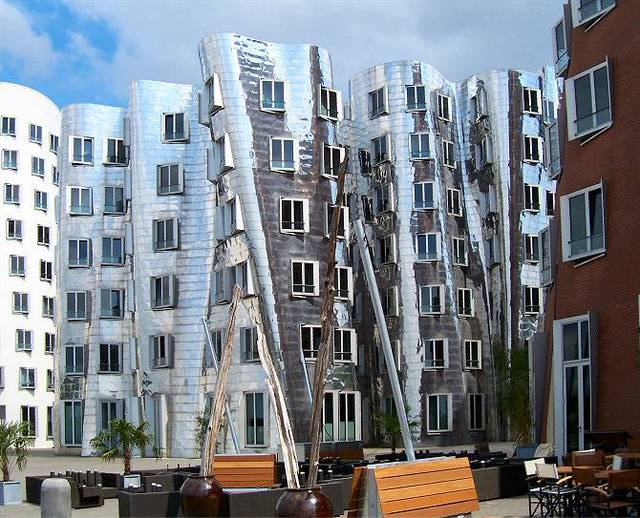
- Medienhafen. At the southern end of the Rhine promenade you will find the newest landmark of Düsseldorf, the so called Media Harbour. The former harbour was transformed into a quarter with restaurants, bars, coffee shops, discotheques and hotels. Its flair is based on the mixture of old and new. Protected buildings like depots, quay walls and industrial surroundings stand side by side with modern architecture. There are buildings constructed by Frank O. Gehry, Claude Vasconi or David Chipperfield. It is mainly the Gehry buildings that form the face of the quarter.
Rheinturm. The 240 m high Rhine Tower is right on the Rhine river, near the Media Harbor. It offers a 360-degree view from the restaurant, at 172 m. The restaurant is overpriced, but it is worth a trip for the amazing view. Adults: € 7.00.
Medienhafen. At the southern end of the Rhine promenade you will find the newest landmark of Düsseldorf, the so called Media Harbour. The former harbour was transformed into a quarter with restaurants, bars, coffee shops, discotheques and hotels. Its flair is based on the mixture of old and new. Protected buildings like depots, quay walls and industrial surroundings stand side by side with modern architecture. There are buildings constructed by Frank O. Gehry, Claude Vasconi or David Chipperfield. It is mainly the Gehry buildings that form the face of the quarter.
- Nordpark. on the right bank of Rhine in the northern city, is one of the major Parks in Düsseldorf. Its most interesting part is the Japanese garden inside, a gift of the Japanese community to the citizens. Within about 5,000 square meters, you will find an example of Japanese horticulture with traditional elements like stones, trees, bushes, ponds and bridges. Entrance is free.
- EKO-Haus, Brüggener Weg 6, 40547 Düsseldorf, +49 211 577 918 0. The house of Japanese culture in the quarter of Niederkassel on the left bank of the Rhein. It was Europe’s first Buddhist temple, and it is surrounded by several buildings like a kindergarten and a library. The garden is styled like a Japanese garden. There are guided tours, but if you respect the dignity of the location they will not prevent you from stepping in without a guide during daytime.
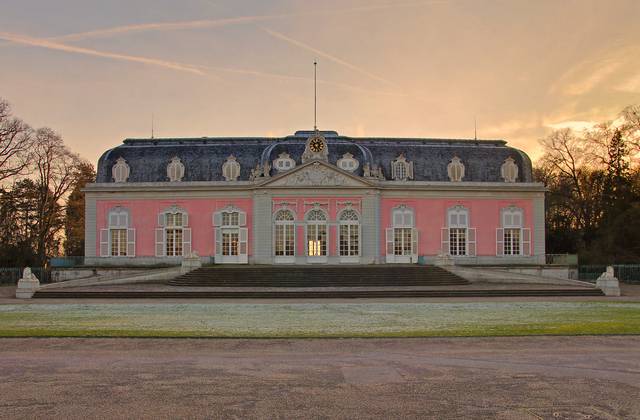
- Benrath Palace and Park. The Corps de Logis is the central building of the three-wing maison de plaisance, which was erected for the Palatine Elector Carl Theodor by his garden and building director Nicolas de Pigage. Construction was completed in 1770: it is a complete work of art that unites architecture and nature in one overlapping concept, and is rated as one of the most beautiful palaces of the rococo epoch. The park beside the Palace is enormous, nearly 62,000 square meters. Take the U74 tram towards Benrath, exit Schloss-Benrath. Can also take the S6 towards Cologne, exit Benrath, then walk about 200m east.
Nordpark. on the right bank of Rhine in the northern city, is one of the major Parks in Düsseldorf. Its most interesting part is the Japanese garden inside, a gift of the Japanese community to the citizens. Within about 5,000 square meters, you will find an example of Japanese horticulture with traditional elements like stones, trees, bushes, ponds and bridges. Entrance is free.
EKO-Haus, Brüggener Weg 6, 40547 Düsseldorf, +49 211 577 918 0. The house of Japanese culture in the quarter of Niederkassel on the left bank of the Rhein. It was Europe’s first Buddhist temple, and it is surrounded by several buildings like a kindergarten and a library. The garden is styled like a Japanese garden. There are guided tours, but if you respect the dignity of the location they will not prevent you from stepping in without a guide during daytime.
Benrath Palace and Park. The Corps de Logis is the central building of the three-wing maison de plaisance, which was erected for the Palatine Elector Carl Theodor by his garden and building director Nicolas de Pigage. Construction was completed in 1770: it is a complete work of art that unites architecture and nature in one overlapping concept, and is rated as one of the most beautiful palaces of the rococo epoch. The park beside the Palace is enormous, nearly 62,000 square meters. Take the U74 tram towards Benrath, exit Schloss-Benrath. Can also take the S6 towards Cologne, exit Benrath, then walk about 200m east.
Throughout Düsseldorf you may encounter life-size figures of people standing on advertising columns, the so-called pillar saints. There are nine of them. It is a project of artist Christoph Pöggeler (born in 1958 in Münster/Westphalia). Humans, removed from their daily routine and put on a pedestal, become noticeable as individuals again and also refer to groups of society like children, business men, vagabonds and strangers. The position of the sculptures are:
- Business Man: Joseph-Beuys-Ufer, Düsseldorf 2001
- Marlis: Stromstraße, WDR, Düsseldorf 2001
- Couple I: Burgplatz, Düsseldorf 2002
- Tourist: Kaiserswerther Straße, Düsseldorf 2003
- Father and Son: Oststraße, Düsseldorf 2003
- Photographer: Hauptbahnhof, Düsseldorf 2004
- Couple II: Berger Allee, Düsseldorf 2004
- Stranger: Schlossufer, Düsseldorf 2005
- Bride: Schulstraße/ Ecke Citadellstraße, Düsseldorf 2006
- Düsseldorf is a stronghold of Carnival. The 5th season starts on 11.11. at 11:11 o'clock with the handover of the keys of the city hall to the women. But the main carnival runs from Carnival Monday to Ash Wednesday. If you have the chance don’t miss the parade on Carnival Monday in February.
- Nacht der Museen. Once a year, like in many other German cities, a Night of Museums is organized by the City of Düsseldorf.
- Christmas market. The annual Christmas market, which centres around the Altstadt. Try a Glühwein (mulled wine) and Bratwurst (grilled sausage in bread roll).
- Kirmes. Between the 2nd and 3rd weekend of July there is fun fair on the banks of Rhine. You will find there roller coasters, a Ferris wheel, a flying jinny and at least a beer garden too. Also, watermelons are sold everywhere. It is the biggest fair on the Rhine and very enjoyable. Monday, called pink Monday, is the day of lesbians and gays. On Friday, there is a firework display.
- Every year in May there is Düsseldorf Marathon which is open for everyone. Registration is required for participants, but viewers are welcome any time.
- Free entrance to the K20 and K21 every first Wednesday in the Month.
Nacht der Museen. Once a year, like in many other German cities, a Night of Museums is organized by the City of Düsseldorf.
Christmas market. The annual Christmas market, which centres around the Altstadt. Try a Glühwein (mulled wine) and Bratwurst (grilled sausage in bread roll).
Kirmes. Between the 2nd and 3rd weekend of July there is fun fair on the banks of Rhine. You will find there roller coasters, a Ferris wheel, a flying jinny and at least a beer garden too. Also, watermelons are sold everywhere. It is the biggest fair on the Rhine and very enjoyable. Monday, called pink Monday, is the day of lesbians and gays. On Friday, there is a firework display.
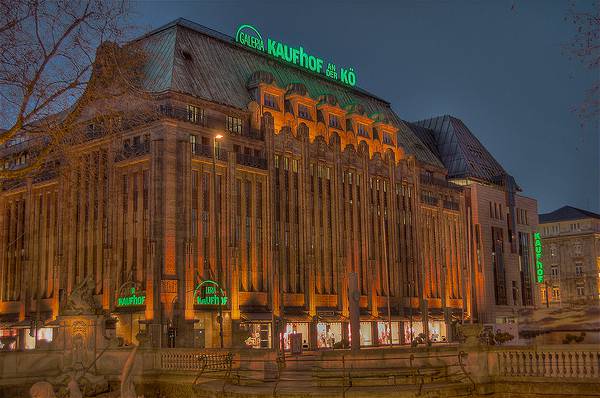 Königsallee, called the Kö by the locals, is the city's main boulevard with high-end stores and boutiques, as well as gourmet restaurants and luxury hotels.
Königsallee, called the Kö by the locals, is the city's main boulevard with high-end stores and boutiques, as well as gourmet restaurants and luxury hotels.
- Breuninger, Königsallee 2. Mo-Sa 10:00-20:00. The Stuttgart-based upscale department store chain has opened their North-Rhein outpost in 2014 in the new Kö-Bogen complex at the north end of the Königsallee. The store is filled with a collection of luxury goods, mainly apparel and accessories, from Germany, Europe and the world. Inside you can also find a premium restaurant operated in a co-branding agreement with the famous Sansibar from Sylt.
- Kaufhof an der Kö. Germany's largest department store chain has taken over the former Kaufhaus Tietz and turned it into a premium flagship for their chain
- KÖ Galerie, Königsallee 60, +49 211 867 81 0. Gallery open daily 7AM-11PM, hours vary across shops. The extensive shopping gallery fills up most the block between Steinstraße and Grünstraße, with multi-level indoor passages featuring exquisite boutiques, as well as a REWE supermarket and a selection of bars, cafes and restaurants.
- Mayersche Droste, Königsallee 18. 10AM-8PM, closed on Sundays. At the corner of Königsallee and Schadowstraße, the six-level store of the Meyersche Buchhandlung (bookstore) chain will most likely be on your way at some point, filled with books, magazines, DVDs and other media. Worth visiting even for the views from the upper-level windows in all directions.
The Schadowstraße is another major shopping street, much more affordable, with department stores and apparel shops from local and international chains.
- Karstadt. The quintessential German department store selling anything from apparel to foodstuffs
- Galeria Kaufhof. Karstadt's main competitor, Galeria Kaufhof, has a huge department store right across the street.
- Schadow-Arkaden, Schadowstraße 11 (right next to Corneliusplatz / Königsallee, +49 211 86 49 20. The three-floor shopping centre at the western end of Schadowstraße features a mix of different retailers and an occasional antique marketplace within its premises.
Another famous department store in Düsseldorf is the Carsch-Haus at Heinrich-Heine-Platz. Opened in 1915 by Paul Carsch, it was rebuilt after the Second World War and continued in operation until 1979, when its façade had to be moved 23 metres back to make room for the U-Bahn station. After this meticulously performed operation, it remains continually open since 1984 under its historic name, despite changing hands and becoming a part of the Hertie chain and ending up as part of Kaufhof AG. Kaufhof positions the store as slightly more upmarket than its own-brand Galerias.
- Carsch-Haus, Heinrich-Heine-Platz 1 (U-Bahn station Heinrich-Heine-Allee, +49 800 - 10 00 209. Monday through Saturday 9:30-20:00.
Other high-end fashion retailers to be found in Düsseldorf include:
- Apropos, Benrather Straße 15.
Those who like trendy fashion should visit the quarter of Flingern, especially Ackerstraße. Recently the quarter has turned from a residential to a creative district, offering stores like the trendy ones you will find in Berlin. Also the district of Pempelfort (Tußmannstraße) and Unterbilk (Lorettostraße) demonstrate that there is a fashion scene beside international fashion houses.
- Killepitsch is a local liquor flavored with herbs (so called "Kräuterlikör"). The liquor has a blood red colour and is made from a combination of 90 fruits, berries, herbs, and spices. Available at Et Kabüffke, Flingerstraße 1, 40213 Düsseldorf, +49 211 1332 69.
- Löwensenf, Berger Straße 29, 40213 Düsseldorf, +49 211 836 8049. One of the most famous producers of German Mustard is situated in Düsseldorf. Moveover, a special mustard store, with a mustard tasting area, is based in the Düsseldorf-Altstadt (some fancy mustards are available at this place: for example "Altbier Mustard", "Chilli Mustard", "Strawberry Mustard", etc.)
- Bottles of Altbier - One nice souvenir or gift is a bottle of local Altbier. Breweries usually sell these bottels directly in their gastronomies.
Killepitsch is a local liquor flavored with herbs (so called "Kräuterlikör"). The liquor has a blood red colour and is made from a combination of 90 fruits, berries, herbs, and spices. Available at Et Kabüffke, Flingerstraße 1, 40213 Düsseldorf, +49 211 1332 69.
Löwensenf, Berger Straße 29, 40213 Düsseldorf, +49 211 836 8049. One of the most famous producers of German Mustard is situated in Düsseldorf. Moveover, a special mustard store, with a mustard tasting area, is based in the Düsseldorf-Altstadt (some fancy mustards are available at this place: for example "Altbier Mustard", "Chilli Mustard", "Strawberry Mustard", etc.)
Bottles of Altbier - One nice souvenir or gift is a bottle of local Altbier. Breweries usually sell these bottels directly in their gastronomies.
Breuninger, Königsallee 2. Mo-Sa 10:00-20:00. The [[Stuttgart]]-based upscale department store chain has opened their North-Rhein outpost in 2014 in the new Kö-Bogen complex at the north end of the Königsallee. The store is filled with a collection of luxury goods, mainly apparel and accessories, from Germany, Europe and the world. Inside you can also find a premium restaurant operated in a co-branding agreement with the famous Sansibar from [[Sylt]].
Kaufhof an der Kö. Germany's largest department store chain has taken over the former Kaufhaus Tietz and turned it into a premium flagship for their chain
KÖ Galerie, Königsallee 60, +49 211 867 81 0. Gallery open daily 7AM-11PM, hours vary across shops. The extensive shopping gallery fills up most the block between Steinstraße and Grünstraße, with multi-level indoor passages featuring exquisite boutiques, as well as a REWE supermarket and a selection of bars, cafes and restaurants.
Mayersche Droste, Königsallee 18. 10AM-8PM, closed on Sundays. At the corner of Königsallee and Schadowstraße, the six-level store of the Meyersche Buchhandlung (bookstore) chain will most likely be on your way at some point, filled with books, magazines, DVDs and other media. Worth visiting even for the views from the upper-level windows in all directions.
Karstadt. The quintessential German department store selling anything from apparel to foodstuffs
Galeria Kaufhof. Karstadt's main competitor, Galeria Kaufhof, has a huge department store right across the street.
Schadow-Arkaden, Schadowstraße 11 (right next to Corneliusplatz / Königsallee, +49 211 86 49 20. The three-floor shopping centre at the western end of Schadowstraße features a mix of different retailers and an occasional antique marketplace within its premises.
Carsch-Haus, Heinrich-Heine-Platz 1 (U-Bahn station Heinrich-Heine-Allee, +49 800 - 10 00 209. Monday through Saturday 9:30-20:00.
Apropos, Benrather Straße 15.
Characteristic Rhenish dishes like Düsseldorfer Senfrostbraten (mustard roast pork), Rheinischer Sauerbraten (marinated beef with raisins), Halve Hahn (not a "half chicken", but a slice of cheese with mustard and a gherkin on rye bread) or Ähzezupp (pea soup) are offered everywhere within the old town.
- Zum Kochlöffel, Friedrich-Ebert-Str. 41, +49 211 1 60 96 15. German cuisine, bistro tables.
- Alberobello, Dorotheenstr. 104, +49 211 7334158. Italian cuisine, budget prices and superb quality. Reservation recommended.
- Curry Hammer Str. 2 (Media Harbour), or Moltkestr. 115 (Pempelfort). German cuisine, including the famous sausage with ketchup (on request with golden leaf!).
- Ess-Klasse Erftstraße 12 (Media Harbour). Lunch and take-away food at affordable prices.
- Dinea, Berliner Allee 52, Königsallee 1-9, Am Wehrhahn 1. 9:30-20. Lunch restaurants and cafés in the 'Galeria Kaufhof' department stores. These are good places for a quick and cheap meal.
Zum Kochlöffel, Friedrich-Ebert-Str. 41, +49 211 1 60 96 15. German cuisine, bistro tables.
Alberobello, Dorotheenstr. 104, +49 211 7334158. Italian cuisine, budget prices and superb quality. Reservation recommended.
Curry Hammer Str. 2 (Media Harbour), or Moltkestr. 115 (Pempelfort). German cuisine, including the famous sausage with ketchup (on request with golden leaf!).
Ess-Klasse Erftstraße 12 (Media Harbour). Lunch and take-away food at affordable prices.
Dinea, Berliner Allee 52, Königsallee 1-9, Am Wehrhahn 1. 9:30-20. Lunch restaurants and cafés in the 'Galeria Kaufhof' department stores. These are good places for a quick and cheap meal.
- Robert's Bistro, Wupperstr. 2, in the Media harbour, +49 211 304821. One of Düsseldorf's best restaurants. Specializing in French-ish food, the fish and sweets are fantastic. Expect to pay 20-30 euros per person (for food and wine). They don't take reservations so expect to wait and sit next to strangers, but the experience is well worth it.
- Mongos, Zollhof 10, Media Harbour, +49 211 - 40 07 27 0. All-you-can-eat Mongolian cuisine, with an enormous choice of unusual foods (i.e. zebra, crocodiles, emu, barracuda, etc.).
- Bug, Zollhof 13, +49 211 3020770. Fish restaurant in the media harbor, known for its stylish location.
- Zum Schiffchen, Hafenstraße 5, +49 211 - 13 24 21. Rustic bourgeois brewery restaurant, delicious beer and attentive service. Excellent cream of Pfifferlinge (chanterelle) soup in season. Established in 1628, this restaurant was patronized by local poet Heinrich Heine and has served a bevy of celebrities, including Napoleon.
- Michele, Duisburger Str. 6, +49 211 494349. A small Italian restaurant in Düsseldorf-Pempelfort. Famous for the singing Italian chef on Friday evenings. For Friday nights, reservations should be made 3 weeks prior to your stay.
- Brauerei im Füchschen, Ratingerstraße 28, +49 211 1374-716. A traditional brewery restaurant in the old town serving their own beer. Here you can try the local specialty Sauerbraten; vinegar marinated beef with red cabbage.
- El Amigo Primo Lopez, Schneider-Wibbel-Gasse 9, +49 211 32 32 03. An Argentinian beef restaurant situated in the old town.
Robert's Bistro, Wupperstr. 2, in the Media harbour, +49 211 304821. One of Düsseldorf's best restaurants. Specializing in French-ish food, the fish and sweets are fantastic. Expect to pay 20-30 euros per person (for food and wine). They don't take reservations so expect to wait and sit next to strangers, but the experience is well worth it.
Mongos, Zollhof 10, Media Harbour, +49 211 - 40 07 27 0. All-you-can-eat Mongolian cuisine, with an enormous choice of unusual foods (i.e. zebra, crocodiles, emu, barracuda, etc.).
Bug, Zollhof 13, +49 211 3020770. Fish restaurant in the media harbor, known for its stylish location.
Zum Schiffchen, Hafenstraße 5, +49 211 - 13 24 21. Rustic bourgeois brewery restaurant, delicious beer and attentive service. Excellent cream of Pfifferlinge (chanterelle) soup in season. Established in 1628, this restaurant was patronized by local poet Heinrich Heine and has served a bevy of celebrities, including Napoleon.
Michele, Duisburger Str. 6, +49 211 494349. A small Italian restaurant in Düsseldorf-Pempelfort. Famous for the singing Italian chef on Friday evenings. For Friday nights, reservations should be made 3 weeks prior to your stay.
Brauerei im Füchschen, Ratingerstraße 28, +49 211 1374-716. A traditional brewery restaurant in the old town serving their own beer. Here you can try the local specialty Sauerbraten; vinegar marinated beef with red cabbage.
El Amigo Primo Lopez, Schneider-Wibbel-Gasse 9, +49 211 32 32 03. An Argentinian beef restaurant situated in the old town.
- Im Schiffchen, Kaiserwerther Markt 9, +49 211 401050. T-Sa 19:00-21:30. (U79: Klemensplatz). International, nouveau cuisine, that blends classics with French specialties.
- Nagaya, Bilker Straße 3, +49 211 863-9636. Mo-Sa from 7PM-11PM. Japanese, nouveau cuisine.
- Sila Thai, Bahnstr. 76, +49 211 8604427. Excellent original thai cuisine in the city center. Reservations essential.
- Meerbar, Neuer Zollhof 1, im Medienhafen, +49 211 3398410. Fish restaurant in the Gehry-buildings of the Media harbour; very stylish, very good cuisine.
Im Schiffchen, Kaiserwerther Markt 9, +49 211 401050. T-Sa 19:00-21:30. (U79: Klemensplatz). International, nouveau cuisine, that blends classics with French specialties.
Nagaya, Bilker Straße 3, +49 211 863-9636. Mo-Sa from 7PM-11PM. Japanese, nouveau cuisine.
Sila Thai, Bahnstr. 76, +49 211 8604427. Excellent original thai cuisine in the city center. Reservations essential.
Meerbar, Neuer Zollhof 1, im Medienhafen, +49 211 3398410. Fish restaurant in the Gehry-buildings of the Media harbour; very stylish, very good cuisine.
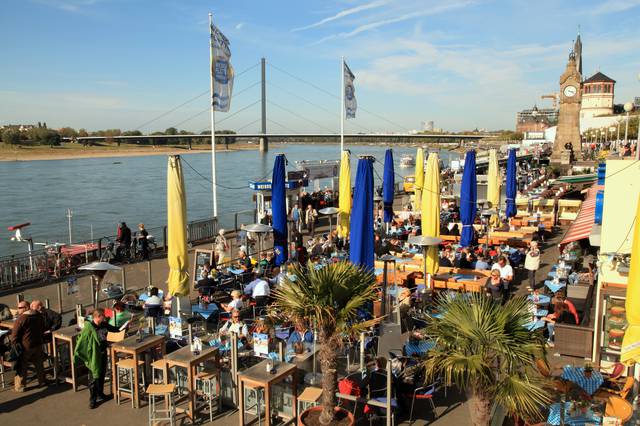
Düsseldorf is known for its many bars in the downtown (Altstadt) area. In fact, many people refer to the Altstadt as the "longest bar in the world" ("Längste Theke der Welt"). The most common drink is "Altbier" or simply "Alt." This dark beer, served in small glasses, is available at practically any restaurant in the city. Altbier is only brewed in breweries around Düsseldorf. Some of the traditional breweries are the "Uerige", "Füchschen", "Zum Schlüssel" and "Schumacher".
In the Altstadt you can enjoy Schlüssel, Uerige, Schumacher, and Füchschen beers, at traditional brewery restaurants. The waiters at these traditional restaurants are called "Köbes." These waiters will replace empty glasses with full ones when they see one. Typically new visitors to the city are surprised by a new fresh glass of Altbier in front of them when they did not order one. To signal that you are done and do not want any more Altbier, simply place your coaster ("Bierdeckel") on top of your glass, and the "Köbes" will not automatically refill you. Bolkerstraße (Zum Schlüssel, Schumacher), Flingerstraße (Uerige), Ratinger Straße (Füchschen) and Kurzestraße (Kürzer) are the main places where you find all kinds of pubs and breweries. A variation of the Altbier is called Krefelder. It's an Altbier with Coke.
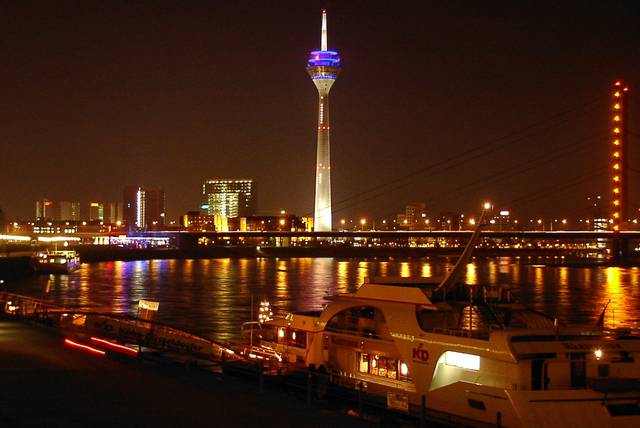 During summer months the Altstadt will come alive after work. People standing outside the pubs and enjoying their beer and good company. This will be especially so on Wednesday evenings on Ratingerstraße. The street will be packed full of people with a great chilled atmosphere. Be aware though of broken glass on the cobbled street. But if you have a chance to go, do not miss it.
During summer months the Altstadt will come alive after work. People standing outside the pubs and enjoying their beer and good company. This will be especially so on Wednesday evenings on Ratingerstraße. The street will be packed full of people with a great chilled atmosphere. Be aware though of broken glass on the cobbled street. But if you have a chance to go, do not miss it.
Besides Altstadt, which some might consider to be slightly artificial, there are many others places around the city to enjoy beer or cocktails as well. In recent years, Medienhafen (Media Harbour) has become one of very popular quarters, especially during the summer. Other areas which are rather non-touristic include Pempelfort (Nordstraße), Unterbilk (Lorettostraße, Düsselstraße), Oberkassel (Luegallee), and Düsseltal (Rethelstraße).
Holy mass in Catholic churches in downtown Düsseldorf:
- Franziskanerkirche, Immermannstraße/Oststraße (near the central station). Su: 10AM, 12PM; M-F: 3:30PM.
- St. Maximilian, Schulstraße/Maxplatz (Altstadt). Su: 10AM, 11:30AM, 6PM; M-Sa: 6PM.
- St. Andreas, Hunsrückenstraße (near the Kunsthalle, Altstadt). Mass times: Sun: 8:30, 11:00, 18:00; Mon-Sat: 12:00, 18:00
- St. Lambertus Basilika minor, Stiftsplatz (near the Rhine bank, Altstadt). Mass times: Sun: 10:30AM, 5PM; Mo-Sa: 5PM.
Jewish:
- Jüdische Gemeinde Düsseldorf
- Chabad of Düsseldorf Jewish Synagogue and Center that holds weekly Sabbath services as well as other events.
Franziskanerkirche, Immermannstraße/Oststraße (near the central station). Su: 10AM, 12PM; M-F: 3:30PM.
St. Maximilian, Schulstraße/Maxplatz (Altstadt). Su: 10AM, 11:30AM, 6PM; M-Sa: 6PM.
St. Andreas, Hunsrückenstraße (near the Kunsthalle, Altstadt). Mass times: Sun: 8:30, 11:00, 18:00; Mon-Sat: 12:00, 18:00
St. Lambertus Basilika minor, Stiftsplatz (near the Rhine bank, Altstadt). Mass times: Sun: 10:30AM, 5PM; Mo-Sa: 5PM.
Chabad of Düsseldorf Jewish Synagogue and Center that holds weekly Sabbath services as well as other events.
Düsseldorf is generally as safe as other European cities of similar size. However the surroundings of the central railway station might be a bit intimidating, particularly at night, if there are junkies around.
Düsseldorf is in a strong rivalry with its neighbor city Cologne, especially concerning comparisons between the local beers. Cologne is almost twice the size of Düsseldorf in terms of population, and the Cologne Cathedral is known nationwide. Düsseldorf is an economic powerhouse and capital city of the state of NRW. If you have been to Cologne, try to avoid any comparisons between the two cities.
- Cologne — the largest city in North Rhine-Westphalia maintaining a legendary rivalry with its close neighbour
- Brühl — almost a suburb of Cologne and contains the Augustusburg Palace which has been placed on the UNESCO World Heritage List. The palace is one of the key works of Balthasar Neuman, and contains one of the finest Rococo interiors in the world, the highlight being the main staircase. Also in the grounds is the magnificent hunting Lodge of Falkenslust. Brühl is easily reached by train. The Phantasialand theme park is also in Brühl.
- Bonn — the former capital of (West) Germany is located due south and easy to reach by train or S-Bahn
- Königswinter and Bad Honnef — small towns at the Middle Rhine Valley reachable by train
- Lower Rhine with the towns of Neuss, Meerbusch and Krefeld
- Ruhr (Ruhrgebiet) — If you are interested in heavy industry and/or industrial culture this might be a worthwhile trip. It is located about 50 km north of Düsseldorf. The region, which was the center of Germany's mining industry (coal and steel) is going through a structural transformation and presents its industrial heritage (not without pride) on the Industrial Heritage Trail.
[[Brühl]] — almost a suburb of Cologne and contains the Augustusburg Palace which has been placed on the [[UNESCO World Heritage List]]. The palace is one of the key works of Balthasar Neuman, and contains one of the finest Rococo interiors in the world, the highlight being the main staircase. Also in the grounds is the magnificent hunting Lodge of Falkenslust. Brühl is easily reached by train. The Phantasialand theme park is also in Brühl.
Due to Düsseldorf's proximity to the German/Belgian/Dutch border weekend trips to foreign destinations are easy to arrange.
- Amsterdam
- Paris
- Brussels
- Eindhoven
- Antwerp
- Arnhem
